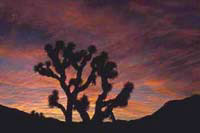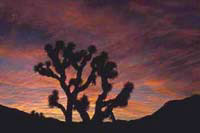With the collapse of the Soviet Union, the U.S. Bureau of Land Management (BLM) controls more land than any other agency in the world. Its 265 million acres in the American West cover an area greater in size than the entire National Forest system plus the state of Wyoming.

You too should care about the joshua tree.
Photo: BLM.
The agency has a long history of rolling over to extractive industries intent on exploiting the public domain. And that record hasn’t fundamentally improved under the Clinton administration, despite the creation of a few new national monuments on BLM-managed lands.
Secretary of the Interior Bruce Babbitt inherited an agency running on outdated management plans based on flawed wilderness inventories. Seven years later, not much has changed. The BLM still hands out oil and gas leases for proposed wilderness and important wildlife habitat. It still allows off-road vehicles (ORVs) to tear through streams and rivers. And it still trades and sells tracts important for recreation and open space on the edges of towns.
As a result, BLM wilderness is lost every day. In my home state of Utah, the BLM is about to approve 500 gas wells and hundreds of miles of new roads in the Lower Bitter Creek, which provides critical mule deer habitat. The agency just signed off on a new road, rock quarry, and crushing operation in the proposed Beaver Dam Mountain wilderness, a rare slice of the Mojave Desert in the Beehive state. And it permitted another well and road in the White River proposed wilderness above a portion of the river proposed for wild and scenic protection, and two more in the Duma Point unit, part of the Labyrinth Canyon wilderness complex.

Ahh … wilderness.
Photo: BLM.
The Southern Utah Wilderness Alliance has appealed all of these decisions, or will. SUWA was also forced to file litigation to protect 9 million acres of BLM roadless land from dirt bikes and other ORVs. The BLM continues to shy away from regulating motorized users. It’s even promoting the use of a rare desert perennial stream that winds through lovely Arch Canyon — another proposed wilderness — as an ORV route.
The losses are West-wide. The Colorado BLM is tearing down pinyon-juniper forests in roadless areas within the Dolores River drainage. More than 80 percent of Nevada BLM land is currently wide open to ORV use. And in Wyoming, the agency projects more than 70,000 new coal-bed methane wells in the Powder River Basin, which will dewater an area the size of New Hampshire and Vermont combined.
The Clinton administration has taken a few small steps to protect BLM lands. President Clinton has established seven national monuments on BLM land that total approximately 3 million acres, and he is likely to designate more. These new monuments may provide welcome protection for a few areas. But shelving 1 percent of the total BLM land base under the Antiquities Act does nothing for the rest of the estimated 160 million acres of BLM roadless areas in the West and Alaska.

The agency needs more flower power.
Photo: BLM.
BLM managers will tell you that their agency lacks the funding to do its job. Congress has long choked the BLM with miserly appropriations. But the obstacle to land protection is more a lack of backbone than dollars. It takes political will to say no to the dirt bikes and drill rigs, not money.
To give these lands a fighting chance, the Clinton administration needs to initiate system-wide reform. It should start by placing the most critical areas — the roadless lands — temporarily off-limits until the agency can conduct new wilderness inventories and amend its land management plans to protect these areas.
The idea of protecting BLM roadless areas isn’t novel. Congress ordered the BLM to do this back in 1976. However, the agency bungled the task and omitted millions of acres of deserving lands. The idea makes sense biologically: Earlier this year, 65 scientists asked Babbitt to inventory and protect BLM roadless areas. It is also popular: 66 percent of Americans support Clinton using his power to protect the estimated 60 million acres of BLM wilderness in the contiguous western states, according to a recent poll. And last May, 100 conservation, hunter, fisher, business, and faith groups petitioned Babbitt to take these steps.
The Clinton administration has a choice in the few remaining months of its term. It can continue to let the BLM wander aimlessly, losing dedicated staff and wilderness as it stumbles along. Or, it can grant the petition and start the BLM down the trail to ecologically and legally sound management.


